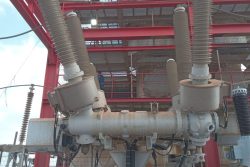Despite the guaranteed payment for rice supplied under the deal with Venezuela, farmers on the Essequibo Coast continue to complain about late payments and this year’s bumper harvest has underlined the need to find new markets.
Earlier this month, Guyana was loading hundreds of containers in one of the year’s last shipments of rice to Venezuela under the PetroCaribe Agreement. General Secretary of the Rice Producers Association (RPA), Dharamkumar Seeraj told Stabroek News in a recent interview that while the paddy quota under the rice agreement has been fulfilled, Guyana was still facing logistical issues in terms of sending rice.
He stated that some millers have begun to use the shipment of rice to Venezuela as a scapegoat for not paying farmers and this had to be addressed. He said that the Venezuelan oil barter agreement under which the Guyana Government pays the exporters here is currently responsible for two-fifths of local exports. “They are starting to blame the government, but that is just two-fifths of exports…that is 200,000 tonnes of rice. We are producing 500,000 now so 300,000 has to be going other places”. He added that it was the millers’ responsibility to find markets. Seeraj, also a Member of Parliament for the PPP/C, told Stabroek News that the Venezuelan Agreement was one-of-a-kind for the area and Guyanese millers have to take on responsibility for selling their product and paying farmers on time.
He stated that recently the RPA and the Guyana Rice Development Board (GRDB) met with millers and rice farmers in Anna Regina to work out a payment plan. He stated that “we held a face-to-face because we had to know and gather information on how farmers are getting paid and when.”
Seeraj stated that “the position is regardless of shipments and to where if you buy paddy you have to pay farmers”. He stated that the millers have gotten into a zone where they pay upfront 50 to 60 percent of the price, but are unable to make the entire payment or withhold the rest of the payment and farmers get frustrated. He stated that Essequibo farmers in particular have been more vocal over the short payments received from millers and for that reason the RPA and the GRDB had to go and address how to work out a payment scheme.
He said that “bringing all the millers together with farmers we want them to pay what they owe first. Second… we address the interest that is owed on top of that”. According to the Rice Factories Act, millers must pay interest after 42 days at two percent over the lending rate at the Bank of Guyana. Seeraj stated that currently that rate can fluctuate for this industry from 11 to 15 percent.
He noted that millers all have a stake in the Venezuelan rice agreement. However, since it is a guaranteed barter deal and the pay is significantly higher, millers rely heavily on the PetroCaribe agreement. Under the US$130M deal, Guyana is responsible for the shipment of 70,000 tonnes of white rice and 140,000 tonnes of paddy with the possibility of more being shipped.
Seeraj revealed that under the rice agreement inclusive of cost, insurance and freight, a tonne of rice is sold for US$800, while the world market can be US$520-620 free on board. He said that millers enjoy the selling price under the Venezuelan agreement but that with a large amount of rice left to be sold/exported due to the record-breaking harvest this year, millers need to be more proactive in finding buyers. Rice production this year exceeded its 500,000-tonne prediction. The Agriculture Ministry reported earlier this month that 529,384 tonnes against 2012’s record- breaking year of 422,000 tonnes had been produced. That figure has since climbed.
During the first crop harvest, Agriculture Minister, Dr Leslie Ramsammy stated that the government was assisting in the sourcing of more export deals with various Caricom countries including Haiti. Panama and Nicaragua in Central America were also being targeted.
Seeraj noted that some millers were aggressively pursuing other markets. He said that all millers have a quota under the Venezuelan deal and that they should be able to pay farmers upon delivery of goods. It was decided at the meeting held by the GRDB and the RPA that some millers had up to Dec 21st to pay farmers not inclusive of the interest owed.
Meanwhile, Head of the Essequibo Paddy Farmers Association (EPFA), Naithram (only name), stated that “it is on the millers to seek markets not the government, but if they are not interested we have to turn somewhere.”
He said that four millers in the Essequibo region have been severely negligent in paying farmers. “I know for me … I sold my paddy and it is going on 90 days now that they promising to pay”.
Naithram told Stabroek News that “all four of these mills owe over 40 percent of payments to farmers…they all paid the 50 percent in the two week, that’s the law, but they are not paying before the 42 days now…they say that it is because of the rice deal and all the rice has gone to Venezuela already”. Naithram also said that millers are alleging that they are once again forced to hold stock because they have nowhere to ship it and therefore can’t pay farmers. The EPFA, chairman stated that this was becoming the norm and the group wanted the ministry to regulate the issue.
He said that mills don’t seem interested in looking past the Venezuelan agreement and famers are suffering as a result.
Across Guyana, 14 mills supply to Venezuela under the rice agreement and of those 14, seven are located in the Essequibo region. Currently, Guyana has over 220,000 acres of land under rice cultivation and while Region 2 is growing approximately 17 percent of the rice in the country it is responsible for approximately 34 percent of the Venezuelan shipment.






